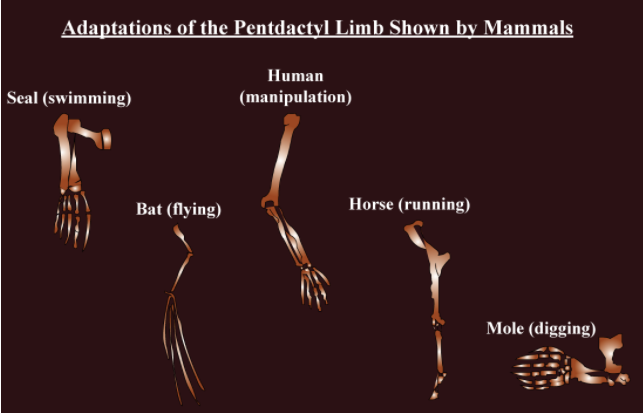
Pentadactyl limb is an example of
A. Analogous Organ
B. Homologous Organ
C. Vestigial Organ
D. All of the above
Answer
497.1k+ views
Hint: They are organs with the same structure but different functions.
Complete answer:
A limb with five digits such as a human hand or foot is called pentadactyl limbs. This pattern of limb bones is an example of homologous structures.
Additional Information:
1. Pentadactyl limbs are found in all classes of tetrapods that are from amphibians to mammals
2. The limb has a single proximal bone (humerus), two distal bones (radius and ulna), a series of carpals (wrist bones), a series of metacarpals (palm bones), and phalanges (digits).
3. Throughout the tetrapods, the basic structure of pentadactyl limbs is the same, indicating that they originated from a common ancestor.
4. During evolution, these limbs got modified, they have become superficially different and unrelated structures to serve different functions in adaptation to different environments and modes of life.
5. This phenomenon generally occurs in the forelimbs of the mammals.
6. It can also help to trace back the fins of certain fossil fishes from which the first amphibians evolved such as Tiktaalik.
So, the correct answer is Homologous Organ.

Note: The best example to explain the pentadactyl limbs is of the horse. The pentadactyl limbs of the horse have evolved and have become something very unique to its purpose and what it does beat is running. Millions of years ago this animal used to be an Eohippus that was very small with a lot more parts to its pentadactyl limb.
Complete answer:
A limb with five digits such as a human hand or foot is called pentadactyl limbs. This pattern of limb bones is an example of homologous structures.
Additional Information:
1. Pentadactyl limbs are found in all classes of tetrapods that are from amphibians to mammals
2. The limb has a single proximal bone (humerus), two distal bones (radius and ulna), a series of carpals (wrist bones), a series of metacarpals (palm bones), and phalanges (digits).
3. Throughout the tetrapods, the basic structure of pentadactyl limbs is the same, indicating that they originated from a common ancestor.
4. During evolution, these limbs got modified, they have become superficially different and unrelated structures to serve different functions in adaptation to different environments and modes of life.
5. This phenomenon generally occurs in the forelimbs of the mammals.
6. It can also help to trace back the fins of certain fossil fishes from which the first amphibians evolved such as Tiktaalik.
So, the correct answer is Homologous Organ.

Note: The best example to explain the pentadactyl limbs is of the horse. The pentadactyl limbs of the horse have evolved and have become something very unique to its purpose and what it does beat is running. Millions of years ago this animal used to be an Eohippus that was very small with a lot more parts to its pentadactyl limb.
Recently Updated Pages
Master Class 9 General Knowledge: Engaging Questions & Answers for Success

Master Class 9 English: Engaging Questions & Answers for Success

Master Class 9 Science: Engaging Questions & Answers for Success

Master Class 9 Social Science: Engaging Questions & Answers for Success

Master Class 9 Maths: Engaging Questions & Answers for Success

Class 9 Question and Answer - Your Ultimate Solutions Guide

Trending doubts
State and prove Bernoullis theorem class 11 physics CBSE

Who built the Grand Trunk Road AChandragupta Maurya class 11 social science CBSE

1 ton equals to A 100 kg B 1000 kg C 10 kg D 10000 class 11 physics CBSE

State the laws of reflection of light

One Metric ton is equal to kg A 10000 B 1000 C 100 class 11 physics CBSE

Difference Between Prokaryotic Cells and Eukaryotic Cells




